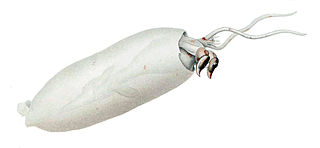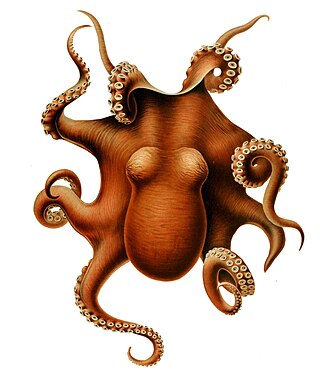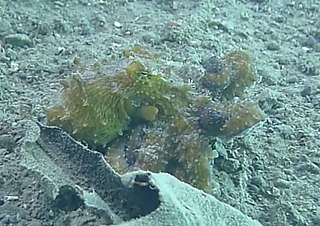
The Mastigoteuthidae, also known as whip-lash squid, are a family of small deep-sea squid. Approximately 20 known species in six genera are represented, with members found in both the mesopelagic and bathypelagic zone of most oceans. Originally described by Verill in 1881, it was later lowered by Chun (1920) to a subfamily (Mastigoteuthinae) of the Chiroteuthidae. However, Roper et al. (1969) raised it back to the family level, and this has not been changed since. The taxonomy of this family is extremely unstable, and there have been at times one genus, two genera and four subgenera(Salcedo-Vargas & Okutani, 1994), two genera and several 'groups', five genera and one species with an uncertain placement, or six genera.

The Octopodidae comprise the family containing the majority of known octopus species.

Abralia is a genus of squid comprising around 20 species from the family Enoploteuthidae. They are small squid which can be found in the epipelagic to mesopelagic zones while some species are found in water with shallow substrates on steep slopes on the boundary of the mesopelagic zone. They are distinguished from other members of the Enoploteuthidae by not normally having large, black photophores at the tips of arms IV, although if these are present they are not covered in black chromatophores, and having fins which extend beyond their tail. The photophores of the integument are characteristicand are found in the three types. "Lensed" photophores are a blue color with a white ring, "simple" photophores are small and violet-colored and the "complex" photophores are surrounded by small green satellite points and have a green centre. The complex photophores will frequently appear to be blue depending on their physiological state. The integument also has small black chromatophores which look like dots. They have 5-12 variably sized photophores on the eye. Either the right or left arm IV is hectocotylized.

Octopus is the largest genus of octopuses, comprising more than 100 species. These species are widespread throughout the world's oceans. Many species formerly placed in the genus Octopus are now assigned to other genera within the family. The octopus has 8 arms, averaging 20 cm long for an adult.

Taoniinae is a subfamily containing ten genera of glass squids.

Pareledone is a genus of octopuses in the family Megaleledonidae.

Graneledone is a genus of octopuses in the family Octopodidae. The type species is Eledone verrucosaVerrill, 1881.
Thaumeledone is a genus of octopuses in the family Octopodidae found in deep waters in the Southern Hemisphere.
Abdopus is a genus of octopuses in the family Octopodidae.

Scaeurgus is a genus of octopuses in the family Octopodidae. The species of this genus are characterized by inhabiting the upper bathyal benthic zone from temperate and tropical latitudes in all major oceans.

The seven-arm octopus is one of the two largest known species of octopus; based on scientific records, it has a maximum estimated total length of 3.5 m (11 ft) and mass of 75 kg (165 lb). The only other similarly large extant species is the giant Pacific octopus, Enteroctopus dofleini.

Callistoctopus is a genus of nocturnal, orange octopuses in the family Octopodidae. They are readily identifiable by their reddish coloring, the white papillae that line their bodies, and their long arms. Though sympatric with diurnal Octopus species, they avoid competition by hunting at night. In acknowledgement of this preference, many species of Callistoctopus are referred to as night octopuses. Well-known species include C. macropus and the type species C. ornatus, both of which are harvested for human consumption as seafood.

Bathypolypus arcticus, the North Atlantic octopus, deep sea octopus or spoonarm octopus is a small species of demersal octopus of the North Atlantic. It is usually found at depths of 200 to 600 m (660–1,970 ft) where the temperature is between 2 and 6 °C (36–43 °F).

Muusoctopus is a cosmopolitan genus of deep-sea octopus from the family Enteroctopodidae. These are small to medium-sized octopuses which lack an ink sac. Recent work has suggested that these octopuses originated in the North Atlantic and subsequently moved into the North Pacific while the species in the Southern Hemisphere are descended from multiple invasions from northern oceans.
Sasakiopus is a genus of octopus containing only one species, Sasakiopus salebrosus, the rough octopus. It is part of the family Enteroctopodidae. Genetic analysis appeared to show that S. salebrosus is the sister taxon of the genera Benthoctopus and Vulcanoctopus, although the former is now considered a synonym of Bathypolypus, the only genus in the family Bathypolypodidae, and the latter as a synonym of Muusoctopus.
Bathypolypus rubrostictus is a species of octopus in the family Bathypolypodidae. Only one male specimen has been found.

Octopus insularis is a species of octopus described in 2008 from individuals found off the coast of Brazil, with a potentially much larger range.

Bathypolypus sponsalis, commonly called the globose octopus, is a deep sea cephalopod that can be found in both the eastern Atlantic Ocean and the Mediterranean Sea. It possesses many morphological traits adapted to a deep sea environment, including large eggs, reduced gills, no ink sac, and subgelatinous tissues. A distinguishing factor are the relatively large reproductive organs. Their diet consists of predominantly crustaceans and molluscs, but they sometimes consume fish as well. Bathypolypus sponsalis usually dies quickly after reproduction and only spawns once in their lifetime. Sexually mature females have a mantle length of at least 34 mm and sexually mature males have a mantle length of about 24 mm. Juveniles are white and transition to dark brown then to dark purple once maturity is reached.

Octopus vitiensis, or the bighead octopus, is a species of octopus provisionally placed in the genus Octopus. It was described by William Evans Hoyle in 1885 based on a specimen found in reefs in Kandavu, Fiji during a voyage of the HMS Challenger.

Abdopus abaculus, or the mosaic octopus, is a species of pygmy octopus. It was first described as Octopus abaculus by M. D. Norman and M. J. Sweeney in 1997 based on specimens caught in Zamboanga del Norte, Philippines.
















